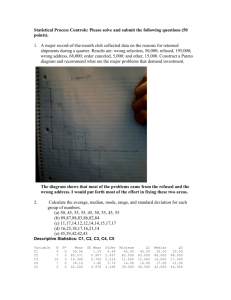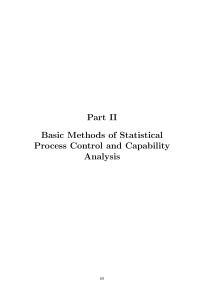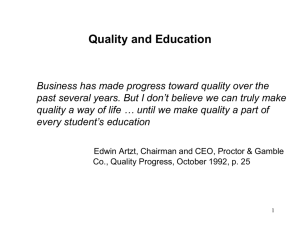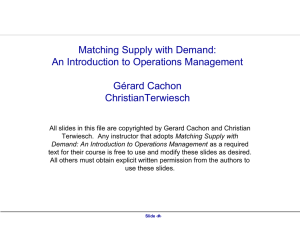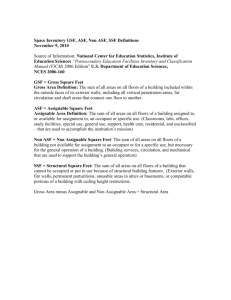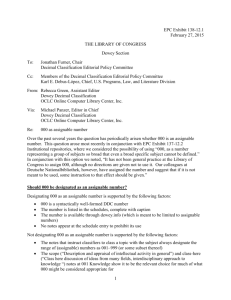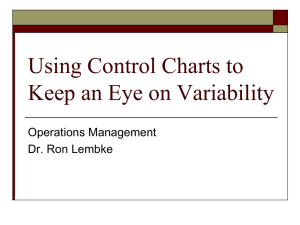Slides for six sigma class
advertisement
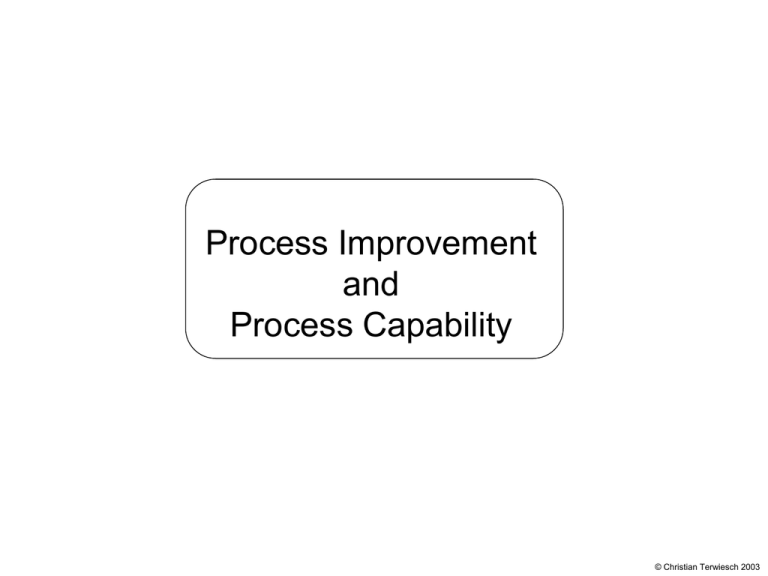
Process Improvement
and
Process Capability
© Christian Terwiesch 2003
The Concept of Yields
Yield of Resource=
Yield of Process=
90%
Flow rate of units processed correctly at the resource
Flow rate
Flow rate of units processed correctly
Flow rate
80%
90%
Line Yield: 0.9 x 0.8 x 0.9 x 1 x 0.9
100%
90%
Rework / Elimination of Flow Units
Step 1
Test 1
Step 2
Test 2
Step 3
Test 3
Rework
Step 1
Step 1
Test 1
Test 1
Step 2
Step 2
Test 2
Test 2
Step 3
Step 3
Test 3
Test 3
Rework:
Defects can be corrected
Same or other resource
Leads to variability
Examples:
- Readmission to ICU
- Toyota case
Loss of Flow units:
Defects can NOT be corrected
Leads to variability
To get X units, we have to
start X/y units
Examples:
- Interviewing
- Semiconductor fab
The Concept of Consistency:
Who is the Better Target Shooter?
Not just the mean is important, but also the variance
Need to look at the distribution function
The Impact of Variation on Quality: The Xootr Case
Variation is (again) the root cause of all evil
Two Types of Causes for Variation
Common Cause Variation (low level)
Common Cause Variation (high level)
Assignable Cause Variation
• Need to measure and reduce common cause variation
• Identify assignable cause variation as soon as possible
Statistical Process Control: Control Charts
• Track process parameter over time
- mean
- percentage defects
Process
Parameter
Upper Control Limit (UCL)
• Distinguish between
- common cause variation
(within control limits)
- assignable cause variation
(outside control limits)
Center Line
Lower Control Limit (LCL)
Time
• Measure process performance:
how much common cause variation
is in the process while the process
is “in control”?
Parameters for Creating X-bar Charts
Number of
Observations
in Subgroup
(n)
2
3
4
5
6
7
8
9
10
Factor for Xbar Chart
(A2)
1.88
1.02
0.73
0.58
0.48
0.42
0.37
0.34
0.31
Factor for
Lower
control Limit
in R chart
(D3)
0
0
0
0
0
0.08
0.14
0.18
0.22
Factor to
Factor for
estimate
Upper
Standard
control limit
deviation, (d2)
in R chart
(D4)
1.128
3.27
1.693
2.57
2.059
2.28
2.326
2.11
2.534
2.00
2.704
1.92
2.847
1.86
2.970
1.82
3.078
1.78
The X-bar Chart: Application to Call Center
Period
1
2
3
4
5
6
7
8
9
10
11
12
13
14
15
16
17
18
19
20
21
22
23
24
25
26
27
x1
x2
1.7
2.7
2.1
1.2
4.4
2.8
3.9
16.5
2.6
1.9
3.9
3.5
29.9
1.9
1.5
3.6
3.5
2.8
2.1
3.7
2.1
3
12.8
2.3
3.8
2.3
2
x3
1.7
2.3
2.7
3.1
2
3.6
2.8
3.6
2.1
4.3
3
8.4
1.9
2.7
2.4
4.3
1.7
5.8
3.2
1.7
2
2.6
2.4
1.6
1.1
1.8
6.7
x4
3.7
1.8
4.5
7.5
3.3
4.5
3.5
2.1
3
1.8
1.7
4.3
7
9
5.1
2.1
5.1
3.1
2.2
3.8
17.1
1.4
2.4
1.8
2.5
1.7
1.8
x5
3.6
3
3.5
6.1
4.5
5.2
3.5
4.2
3.5
2.9
2.1
1.8
6.5
3.7
2.5
5.2
1.8
8
2
1.2
3
1.7
3
5
4.5
11.2
6.3
2.8
2.1
2.9
3
1.4
2.1
3.1
3.3
2.1
2.1
5.1
5.4
2.8
7.9
10.9
1.3
3.2
4.3
1
3.6
3.3
1.8
3.3
1.5
3.6
4.9
1.6
Average
Mean
Range
2.7
2
2.38
1.2
3.14
2.4
4.18
6.3
3.12
3.1
3.64
3.1
3.36
1.1
5.94
14.4
2.66
1.4
2.6
2.5
3.16
3.4
4.68
6.6
9.62
28
5.04
7.1
4.48
9.4
3.3
3.9
3.06
3.4
4.8
5.2
2.1
2.2
2.8
2.6
5.5
15.1
2.1
1.6
4.78
10.4
2.44
3.5
3.1
3.4
4.38
9.5
3.68
5.1
3.81
5.85
• Collect samples over time
• Compute the mean:
x1 x2 ... xn
X
n
• Compute the range:
R max{ x1 , x2 ,...xn }
min{ x1 , x2 ,...xn }
as a proxy for the variance
• Average across all periods
- average mean
- average range
• Normally distributed
Control Charts: The X-bar Chart
• Define control limits
UCL= X +A2 × R =3.81+0.58*5.85=7.19
LCL= X -A2 × R =3.81-0.58*5.85=0.41
12
• Constants are taken from a table
10
• Identify assignable causes:
- point over UCL
- point below LCL
- many (6) points on one side of center
8
6
4
2
0
1
3
5
mean
st-dev
7
9
11 13 15 17 19 21 23 25 27
CSR 1
2.95
0.96
CSR 2
3.23
2.36
• In this case:
- problems in period 13
- new operator was assigned
CSR 3
7.63
7.33
CSR 4
3.08
1.87
CSR 5
4.26
4.41
The Statistical Meaning of Six Sigma
Process capability measure
Upper
Specification
Limit (USL)
Lower
Specification
Limit (LSL)
Process A
(with st. dev sA)
X-3sA
X-2sA
X-1sA
X
X+1sA X+2s
X+3sA
3s
Process B
(with st. dev sB)
X-6sB
X
Cp
USL LSL
6sˆ
xs
Cp
P{defect}
ppm
1s
0.33
0.317
317,000
2s
0.67
0.0455
45,500
3s
1.00
0.0027
2,700
4s
1.33
0.0001
63
5s
1.67
0.0000006
0,6
6s
2.00
2x10-9
0,00
X+6sB
• Estimate standard deviation: ŝ =R /d2
• Look at standard deviation relative to specification limits
• Don’t confuse control limits with specification limits: a process can be out of
control, yet be incapable
Attribute Based Control Charts: The p-chart
Period
1
2
3
4
5
6
7
8
9
10
11
12
13
14
15
16
17
18
19
20
21
22
23
24
25
26
27
28
29
30
n
300
300
300
300
300
300
300
300
300
300
300
300
300
300
300
300
300
300
300
300
300
300
300
300
300
300
300
300
300
300
defects
18
15
18
6
20
16
16
19
20
16
10
14
21
13
13
13
17
17
21
18
16
14
33
46
10
12
13
18
19
14
p
0.060
0.050
0.060
0.020
0.067
0.053
0.053
0.063
0.067
0.053
0.033
0.047
0.070
0.043
0.043
0.043
0.057
0.057
0.070
0.060
0.053
0.047
0.110
0.153
0.033
0.040
0.043
0.060
0.063
0.047
• Estimate average defect percentage
p =0.052
• Estimate Standard Deviation
ŝ =
p(1 p)
Sample Size
=0.013
• Define control limits
UCL= p + 3ŝ =0.091
LCL= p- 3ŝ =0.014
• DAV case:
- calibration period (capability analysis)
- conformance analysis
Attribute Based Control Charts: The p-chart
0.180
0.160
0.140
0.120
0.100
0.080
0.060
0.040
0.020
0.000
13 14 15 16 17 18 19 20 21 22 23 24 25 26 27 28 29 30
Statistical Process Control
Capability
Analysis
Eliminate
Assignable Cause
Conformance
Analysis
Investigate for
Assignable Cause
Capability analysis
• What is the currently "inherent" capability of my process when it is "in control"?
Conformance analysis
• SPC charts identify when control has likely been lost and assignable cause
variation has occurred
Investigate for assignable cause
• Find “Root Cause(s)” of Potential Loss of Statistical Control
Eliminate or replicate assignable cause
• Need Corrective Action To Move Forward
How do you get to a Six Sigma Process?
Step 1: Do Things Consistently (ISO 9000)
1. Management Responsibility
2. Quality System
3. Contract review
4. Design control
5. Document control
6. Purchasing / Supplier evaluation
7. Handling of customer supplied material
8. Products must be traceable
9. Process control
10. Inspection and testing
11. Inspection, Measuring, Test Equipment
12. Records of inspections and tests
13. Control of nonconforming products
14. Corrective action
15. Handling, storage, packaging, delivery
16. Quality records
17. Internal quality audits
18. Training
19. Servicing
20. Statistical techniques
Examples: “The design process shall be planned”,
“production processes shall be defined and planned”
Step 2: Reduce Variability in the Process
The Idea of Taguchi: Even Small Deviations are Quality Losses
Quality
Quality
Loss
Loss = C(x-T)2
Performance
Metric, x
Good
Performance
Metric
Bad
Minimum
acceptable
value
Target
value
Maximum
acceptable
value
Target
value
It is not enough to look at “Good” vs “Bad” Outcomes
Only looking at good vs bad wastes opportunities for learning; especially as failures
become rare (closer to six sigma) you need to learn from the “near misses”
Catapult: Land “in the box” opposed to “perfect on target”
Step 3: Accommodate Residual Variability
Through Robust Design
Chewiness of Brownie=F1(Bake Time) + F2(Oven Temperature)
F1
F2
25 min.
30 min. Bake Time
350 F
Design A
Design B
• Double-checking (see Toshiba)
• Fool-proofing, Poka yoke (see Toyota)
• Process recipe (see Brownie)
Pictures from www.qmt.co.uk
375 F Oven
Temperature
The Case of Jesica Santillam
Jesica Santillam, 17, has waited three years for donor
organs to become available. (Photo: AP)
Line of Causes leading to the mismatch
• Jaggers did not take home the list of blood types
• Coordinator initially misspelled Jesica’s name
• Once UNOS identified Jesica, no further check on blood type
• Little confidence in information system / data quality
• Pediatric nurse did not double check
• Harvest-surgeon did not know blood type
The Case of Jesica Santillam (ctd)
“We didn’t have enough checks”, Ralph Snyderman, Duke University Hospital
Not the first death in organ transplantation because of blood type mismatch
As a result of this tragic event, it is clear to us at Duke that we need to have more robust
processes internally and a better understanding of the responsibilities of all partners
involved in the organ procurement process," said William Fulkerson, M.D., CEO of Duke
University Hospital.
Why Having a Process is so Important:
Two Examples of Rare-Event Failures
Case 1: Process does not matter in most cases
• Airport security
• Safety elements (e.g. seat-belts)
“Bad” outcome only happens
Every 10 Mio units
1 problem every 10,000 units
99% correct
Case 2: Process has built-in rework loops
• Double-checking
• Jesica’s case
99%
Good
99%
99%
1%
1%
1%
Bad
“Bad” outcome only happens with probability (1-0.99)3
Learning should be driven by process deviations, not by defects
The Three Steps in the Case of Jesica
Step 1: Define and map processes
- Jaegger had probably forgotten the list with blood groups 20 times before
- Persons involved in the process did not double-check,
everybody checked sometimes
- Learning is triggered following deaths / process deviations are ignored
Step 2: Reduce variability
- quality of data (initially misspelled the name)
Step 3: Robust Design
- color coding between patient card / box holding the organ
- information system with no manual work-around
To End with a Less Sad Perspective:
Predicting Distance can be Important…
© www.jochen-schweizer.de
